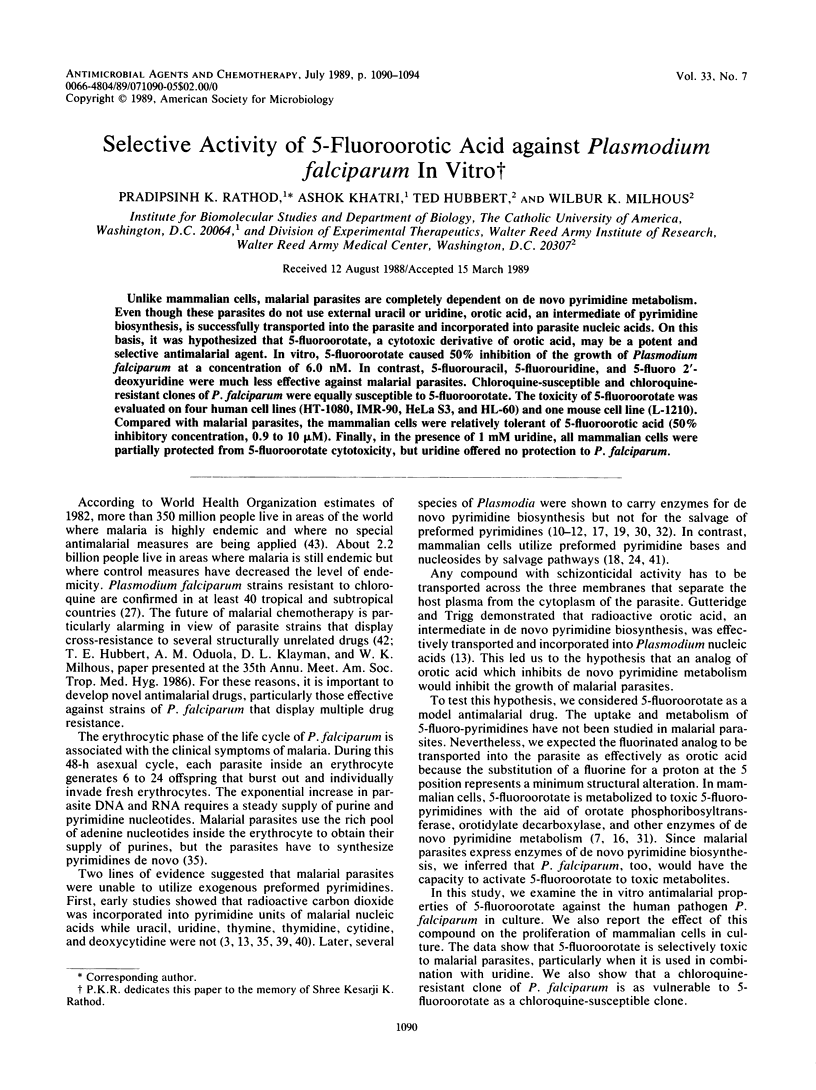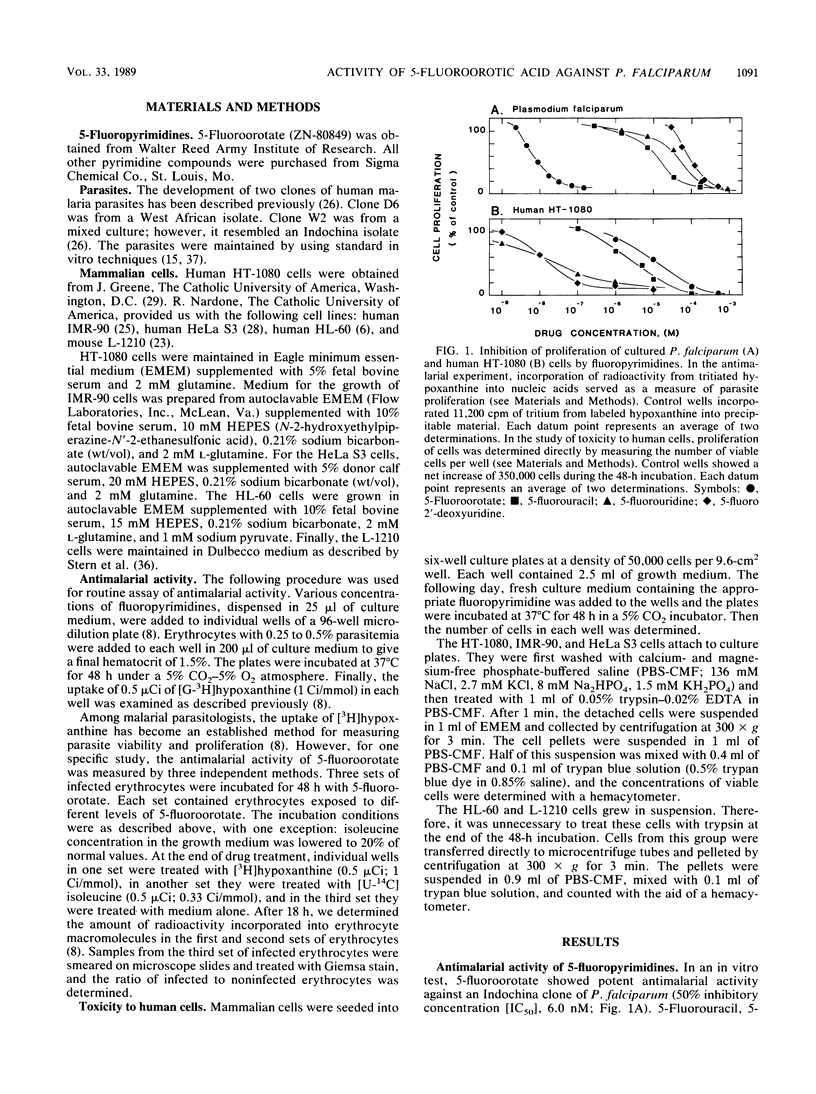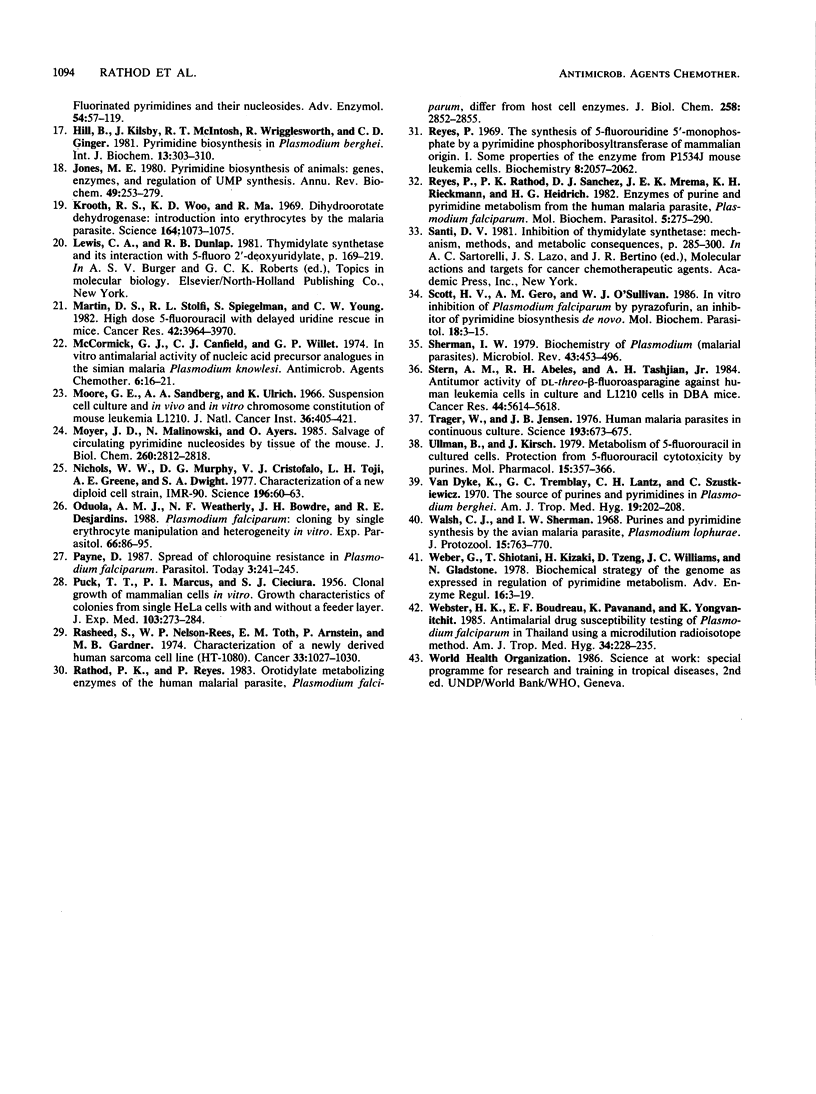Abstract
Unlike mammalian cells, malarial parasites are completely dependent on de novo pyrimidine metabolism. Even though these parasites do not use external uracil or uridine, orotic acid, an intermediate of pyrimidine biosynthesis, is successfully transported into the parasite and incorporated into parasite nucleic acids. On this basis, it was hypothesized that 5-fluoroorotate, a cytotoxic derivative of orotic acid, may be a potent and selective antimalarial agent. In vitro, 5-fluoroorotate caused 50% inhibition of the growth of Plasmodium falciparum at a concentration of 6.0 nM. In contrast, 5-fluorouracil, 5-fluorouridine, and 5-fluoro 2'-deoxyuridine were much less effective against malarial parasites. Chloroquine-susceptible and chloroquine-resistant clones of P. falciparum were equally susceptible to 5-fluoroorotate. The toxicity of 5-fluoroorotate was evaluated on four human cell lines (HT-1080, IMR-90, HeLa S3, and HL-60) and one mouse cell line (L-1210). Compared with malarial parasites, the mammalian cells were relatively tolerant of 5-fluoroorotic acid (50% inhibitory concentration, 0.9 to 10 microM). Finally, in the presence of 1 mM uridine, all mammalian cells were partially protected from 5-fluoroorotate cytotoxicity, but uridine offered no protection to P. falciparum.
Full text
PDF




Selected References
These references are in PubMed. This may not be the complete list of references from this article.
- BOSCH L., HARBERS E., HEIDELBERGER C. Studies on fluorinated pyrimidines. V. Effects on nucleic acid metabolism in vitro. Cancer Res. 1958 Apr;18(3):335–343. [PubMed] [Google Scholar]
- Berlin R. D., Oliver J. M. Membrane transport of purine and pyrimidine bases and nucleosides in animal cells. Int Rev Cytol. 1975;42:287–336. doi: 10.1016/s0074-7696(08)60983-3. [DOI] [PubMed] [Google Scholar]
- Bzik D. J., Li W. B., Horii T., Inselburg J. Molecular cloning and sequence analysis of the Plasmodium falciparum dihydrofolate reductase-thymidylate synthase gene. Proc Natl Acad Sci U S A. 1987 Dec;84(23):8360–8364. doi: 10.1073/pnas.84.23.8360. [DOI] [PMC free article] [PubMed] [Google Scholar]
- Büngener W., Nielsen G. Nukleinsäurenstoffwechsel bei experimenteller Malarie. 1. Untersuchungen über den Einbau von Thymidin, Uridin und Adenosin in Malariaparasiten (Plasmodium berghei und Plasmodium vinckei) Z Tropenmed Parasitol. 1967 Dec;18(4):456–462. [PubMed] [Google Scholar]
- Chen G. X., Zolg J. W. Purification of the bifunctional thymidylate synthase-dihydrofolate reductase complex from the human malaria parasite Plasmodium falciparum. Mol Pharmacol. 1987 Dec;32(6):723–730. [PubMed] [Google Scholar]
- Collins S. J., Gallo R. C., Gallagher R. E. Continuous growth and differentiation of human myeloid leukaemic cells in suspension culture. Nature. 1977 Nov 24;270(5635):347–349. doi: 10.1038/270347a0. [DOI] [PubMed] [Google Scholar]
- DAHL J. L., WAY J. L., PARKS R. E., Jr The enzymatic synthesis of 5-fluorouridine 5'-phosphate. J Biol Chem. 1959 Nov;234:2998–3002. [PubMed] [Google Scholar]
- Desjardins R. E., Canfield C. J., Haynes J. D., Chulay J. D. Quantitative assessment of antimalarial activity in vitro by a semiautomated microdilution technique. Antimicrob Agents Chemother. 1979 Dec;16(6):710–718. doi: 10.1128/aac.16.6.710. [DOI] [PMC free article] [PubMed] [Google Scholar]
- Garrett C. E., Coderre J. A., Meek T. D., Garvey E. P., Claman D. M., Beverley S. M., Santi D. V. A bifunctional thymidylate synthetase-dihydrofolate reductase in protozoa. Mol Biochem Parasitol. 1984 Apr;11:257–265. doi: 10.1016/0166-6851(84)90070-7. [DOI] [PubMed] [Google Scholar]
- Gero A. M., Brown G. V., O'Sullivan W. J. Pyrimidine de novo synthesis during the life cycle of the intraerythrocytic stage of Plasmodium falciparum. J Parasitol. 1984 Aug;70(4):536–541. [PubMed] [Google Scholar]
- Gero A. M., Tetley K., Coombs G. H., Phillips R. S. Dihydroorotate dehydrogenase, orotate phosphoribosyltransferase and orotidine-5'-phosphate decarboxylase in Plasmodium falciparum. Trans R Soc Trop Med Hyg. 1981;75(5):719–720. doi: 10.1016/0035-9203(81)90162-0. [DOI] [PubMed] [Google Scholar]
- Gutteridge W. E., Dave D., Richards W. H. Conversion of dihydroorotate to orotate in parasitic protozoa. Biochim Biophys Acta. 1979 Feb 1;582(3):390–401. doi: 10.1016/0304-4165(79)90131-4. [DOI] [PubMed] [Google Scholar]
- Gutteridge W. E., Trigg P. I. Incorporation of radioactive precursors into DNA and RNA of Plasmodium knowlesi in vitro. J Protozool. 1970 Feb;17(1):89–96. doi: 10.1111/j.1550-7408.1970.tb05163.x. [DOI] [PubMed] [Google Scholar]
- Hammond D. J., Burchell J. R., Pudney M. Inhibition of pyrimidine biosynthesis de novo in Plasmodium falciparum by 2-(4-t-butylcyclohexyl)-3-hydroxy-1,4-naphthoquinone in vitro. Mol Biochem Parasitol. 1985 Jan;14(1):97–109. doi: 10.1016/0166-6851(85)90109-4. [DOI] [PubMed] [Google Scholar]
- Haynes J. D., Diggs C. L., Hines F. A., Desjardins R. E. Culture of human malaria parasites Plasmodium falciparum. Nature. 1976 Oct 28;263(5580):767–769. doi: 10.1038/263767a0. [DOI] [PubMed] [Google Scholar]
- Hill B., Kilsby J., McIntosh R. T., Wrigglesworth R., Ginger C. D. Pyrimidine biosynthesis in Plasmodium berghei. Int J Biochem. 1981;13(3):303–310. doi: 10.1016/0020-711x(81)90082-3. [DOI] [PubMed] [Google Scholar]
- Jones M. E. Pyrimidine nucleotide biosynthesis in animals: genes, enzymes, and regulation of UMP biosynthesis. Annu Rev Biochem. 1980;49:253–279. doi: 10.1146/annurev.bi.49.070180.001345. [DOI] [PubMed] [Google Scholar]
- Krooth R. S., Wuu K. D., Ma R. Dihydroorotic acid dehydrogenase: introduction into erythrocyte by the malaria parasite. Science. 1969 May 30;164(3883):1073–1075. doi: 10.1126/science.164.3883.1073. [DOI] [PubMed] [Google Scholar]
- Martin D. S., Stolfi R. L., Sawyer R. C., Spiegelman S., Young C. W. High-dose 5-fluorouracil with delayed uridine "rescue" in mice. Cancer Res. 1982 Oct;42(10):3964–3970. [PubMed] [Google Scholar]
- McCormick G. J., Canfield C. J., Willet G. P. In vitro antimalarial activity of nucleic acid precursor analogues in the simian malaria Plasmodium knowlesi. Antimicrob Agents Chemother. 1974 Jul;6(1):16–21. doi: 10.1128/aac.6.1.16. [DOI] [PMC free article] [PubMed] [Google Scholar]
- Moyer J. D., Malinowski N., Ayers O. Salvage of circulating pyrimidine nucleosides by tissues of the mouse. J Biol Chem. 1985 Mar 10;260(5):2812–2818. [PubMed] [Google Scholar]
- Nichols W. W., Murphy D. G., Cristofalo V. J., Toji L. H., Greene A. E., Dwight S. A. Characterization of a new human diploid cell strain, IMR-90. Science. 1977 Apr 1;196(4285):60–63. doi: 10.1126/science.841339. [DOI] [PubMed] [Google Scholar]
- Oduola A. M., Weatherly N. F., Bowdre J. H., Desjardins R. E. Plasmodium falciparum: cloning by single-erythrocyte micromanipulation and heterogeneity in vitro. Exp Parasitol. 1988 Jun;66(1):86–95. doi: 10.1016/0014-4894(88)90053-7. [DOI] [PubMed] [Google Scholar]
- PUCK T. T., MARCUS P. I., CIECIURA S. J. Clonal growth of mammalian cells in vitro; growth characteristics of colonies from single HeLa cells with and without a feeder layer. J Exp Med. 1956 Feb 1;103(2):273–283. doi: 10.1084/jem.103.2.273. [DOI] [PMC free article] [PubMed] [Google Scholar]
- Payne D. Spread of chloroquine resistance in Plasmodium falciparum. Parasitol Today. 1987 Aug;3(8):241–246. doi: 10.1016/0169-4758(87)90147-5. [DOI] [PubMed] [Google Scholar]
- Rasheed S., Nelson-Rees W. A., Toth E. M., Arnstein P., Gardner M. B. Characterization of a newly derived human sarcoma cell line (HT-1080). Cancer. 1974 Apr;33(4):1027–1033. doi: 10.1002/1097-0142(197404)33:4<1027::aid-cncr2820330419>3.0.co;2-z. [DOI] [PubMed] [Google Scholar]
- Rathod P. K., Reyes P. Orotidylate-metabolizing enzymes of the human malarial parasite, Plasmodium falciparum, differ from host cell enzymes. J Biol Chem. 1983 Mar 10;258(5):2852–2855. [PubMed] [Google Scholar]
- Reyes P., Rathod P. K., Sanchez D. J., Mrema J. E., Rieckmann K. H., Heidrich H. G. Enzymes of purine and pyrimidine metabolism from the human malaria parasite, Plasmodium falciparum. Mol Biochem Parasitol. 1982 May;5(5):275–290. doi: 10.1016/0166-6851(82)90035-4. [DOI] [PubMed] [Google Scholar]
- Reyes P. The synthesis of 5-fluorouridine 5'-phosphate by a pyrimidine phosphoribosyltransferase of mammalian origin. I. Some properties of the enzyme from P1534J mouse leukemic cells. Biochemistry. 1969 May;8(5):2057–2062. doi: 10.1021/bi00833a041. [DOI] [PubMed] [Google Scholar]
- Scott H. V., Gero A. M., O'Sullivan W. J. In vitro inhibition of Plasmodium falciparum by pyrazofurin, an inhibitor of pyrimidine biosynthesis de novo. Mol Biochem Parasitol. 1986 Jan;18(1):3–15. doi: 10.1016/0166-6851(86)90045-9. [DOI] [PubMed] [Google Scholar]
- Sherman I. W. Biochemistry of Plasmodium (malarial parasites). Microbiol Rev. 1979 Dec;43(4):453–495. doi: 10.1128/mr.43.4.453-495.1979. [DOI] [PMC free article] [PubMed] [Google Scholar]
- Stern A. M., Abeles R. H., Tashjian A. H., Jr Antitumor activity of DL-threo-beta-fluoroasparagine against human leukemia cells in culture and L1210 cells in DBA mice. Cancer Res. 1984 Dec;44(12 Pt 1):5614–5618. [PubMed] [Google Scholar]
- Trager W., Jensen J. B. Human malaria parasites in continuous culture. Science. 1976 Aug 20;193(4254):673–675. doi: 10.1126/science.781840. [DOI] [PubMed] [Google Scholar]
- Ullman B., Kirsch J. Metabolism of 5-fluorouracil in cultured cells. Protection from 5-fluorouracil cytotoxicity by purines. Mol Pharmacol. 1979 Mar;15(2):357–366. [PubMed] [Google Scholar]
- Van Dyke K., Tremblay G. C., Lantz C. H., Szustkiewicz C. The source of purines and pyrimidines in Plasmodium berghei. Am J Trop Med Hyg. 1970 Mar;19(2):202–208. doi: 10.4269/ajtmh.1970.19.202. [DOI] [PubMed] [Google Scholar]
- Walsh C. J., Sherman I. W. Purine and pyrimidine synthesis by the avian malaria parasite, Plasmodium lophurae. J Protozool. 1968 Nov;15(4):763–770. doi: 10.1111/j.1550-7408.1968.tb02209.x. [DOI] [PubMed] [Google Scholar]
- Weber G., Shiotani T., Kizaki H., Tzeng D., Williams J. C., Gladstone N. Biochemical strategy of the genome as expressed in regulation of pyrimidine metabolism. Adv Enzyme Regul. 1977 Oct 3;16:3–19. doi: 10.1016/0065-2571(78)90064-x. [DOI] [PubMed] [Google Scholar]
- Webster H. K., Boudreau E. F., Pavanand K., Yongvanitchit K., Pang L. W. Antimalarial drug susceptibility testing of Plasmodium falciparum in Thailand using a microdilution radioisotope method. Am J Trop Med Hyg. 1985 Mar;34(2):228–235. doi: 10.4269/ajtmh.1985.34.228. [DOI] [PubMed] [Google Scholar]


